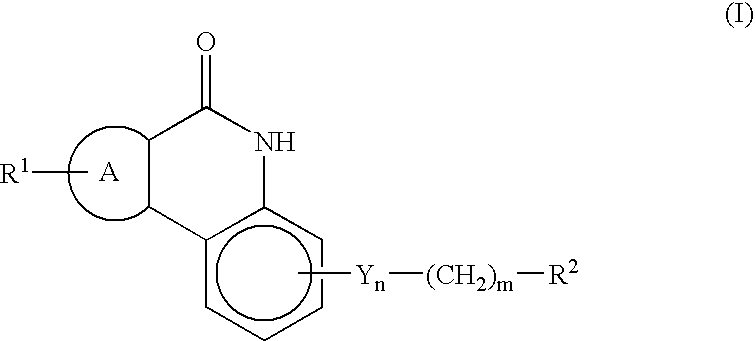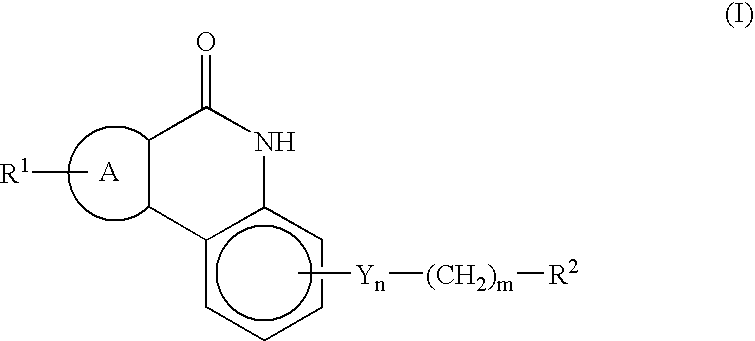Phenanthridinones as parp inhibitors
a technology of parp inhibitors and phenanthridinones, which is applied in the field of new drugs, can solve the problems of cell death and depletion of nad and atp, and achieve the effects of enhancing dna repair, preventing radiosensitization of hypoxic tumor cells, and prolonging the life-span and proliferative capacity of cells
- Summary
- Abstract
- Description
- Claims
- Application Information
AI Technical Summary
Benefits of technology
Problems solved by technology
Method used
Image
Examples
reference example 1
[0109] Under ice cooling, ethyl chloroformate (8.04 g) was added over 30 minutes to a solution of 3-(4-aminophenyl)propanoic acid (10.2 g) in 50% aqueous THF (100 ml) while pH of the solution was maintained between 8 and 10. The solution was stirred for 30 minutes under ice cooling and then sodium chloride (30 g) and EtOAc (50 ml) was added to the solution. The organic layer was separated. The aqueous layer was acidified with 10% aqueous hydrogen chloride and extracted with EtOAc. The combined organic layer was washed with brine, dried over magnesium sulfate and evaporated to give 3-{4-[(ethoxycarbonyl)amino]phenyl}-propanoic acid (10.2 g). 1H-NMR (DMSO-d6) δ: 1.23(3H, t, J=7.1 Hz), 2.4-2.6(2H, m), 2.7-2.8(2H, m), 4.10(2H, q, J=7.1 Hz), 7.07(2H, d, J=8.5 Hz), 7.34(2H, d, J=8.5 Hz), 9.49(1H, s).
[0110] Mass: 236.27 (M-H)−.
reference example 2
[0111] Ethyl 4-(4-hydroxybutyl)phenylcarbamate was obtained in a similar manner to Reference Example 1.
[0112]1H-NMR (DMSO-d6) δ: 1.23(3H, t, J=7.1 Hz), 1.35-1.65(4H, m), 2.45-2.55(2H, m), 3.3-3.45(2H, m), 4.10(2H, q, J=7.1 Hz), 4.33(1H, t, J=5.2 Hz), 7.07(2H, d, J=8.5 Hz), 7.34(2H, d, J=8.5 Hz), 9.46(1H, s)
[0113] Mass: 260.2 (M+Na)+.
reference example 3
[0114] Bromine (3.51 g) was added to a solution of ethyl 4-(3-hydroxypropyl)phenylcarbamate (4.46 g) and sodium acetate (3.28 g) in AcOH (50 ml), and the mixture was stirred for 5 hours. After evaporation of the solvent, the residue was diluted with a mixture of water and EtOAc. The separated organic layer was washed with an aqueous saturated sodium hydrogencarbonate solution, an aqueous sodium thiosulfate solution and brine, successively and dried over magnesium sulfate. After evaporation of the solvent, the residue was purified by column chromatography on silica-gel eluting with a mixture of n-hexane and EtOAc to give ethyl 2-bromo-4-(3-hydroxypropyl)phenylcarbamate (5.53 g).
[0115]1H-NMR (DMSO-d6) δ:1.32(3H, t, J=7.1 Hz), 1.8-2.0(2H, m), 2.65(2H, t, J=7.2 Hz), 3.6-3.7(2H, m), 4.23(2H, q, J=7.1 Hz), 7.02(1H, br s), 7.13(1H, dd, J=8.4, 2.0 Hz), 7.35(1H, d, J=2.0 Hz), 8.01(1H, d, J=8.4 Hz).
[0116] Mass: 303.67 (M+H)+.
PUM
 Login to View More
Login to View More Abstract
Description
Claims
Application Information
 Login to View More
Login to View More - R&D
- Intellectual Property
- Life Sciences
- Materials
- Tech Scout
- Unparalleled Data Quality
- Higher Quality Content
- 60% Fewer Hallucinations
Browse by: Latest US Patents, China's latest patents, Technical Efficacy Thesaurus, Application Domain, Technology Topic, Popular Technical Reports.
© 2025 PatSnap. All rights reserved.Legal|Privacy policy|Modern Slavery Act Transparency Statement|Sitemap|About US| Contact US: help@patsnap.com



